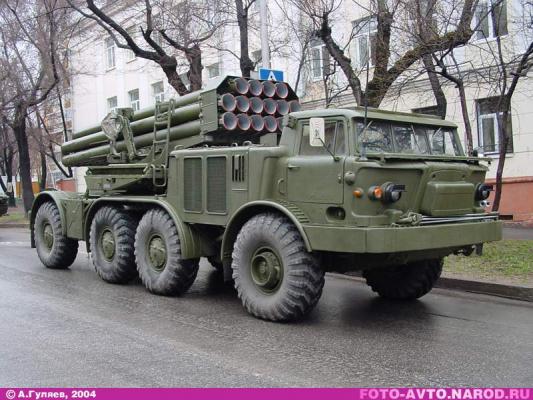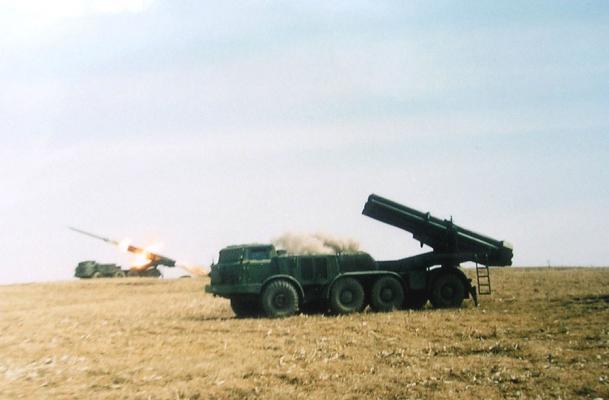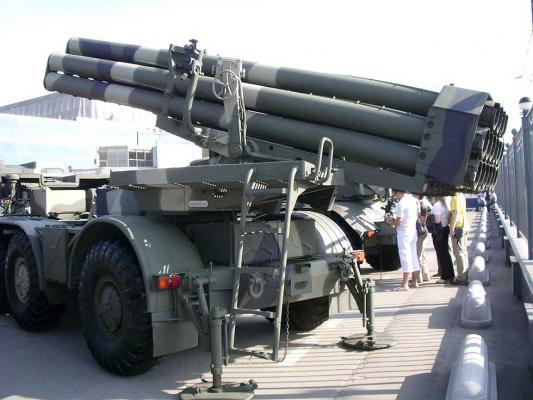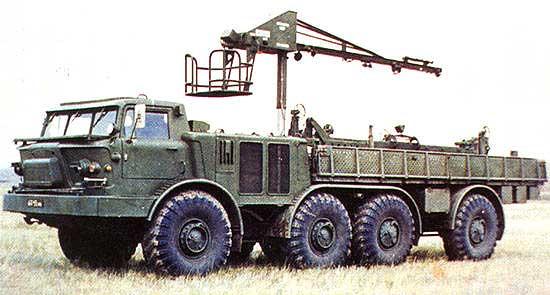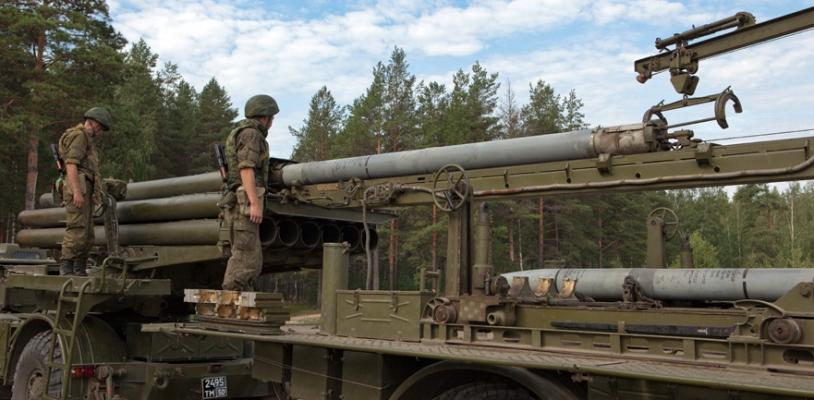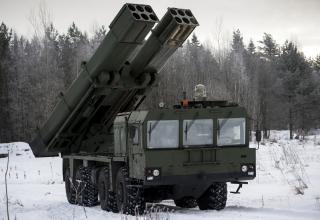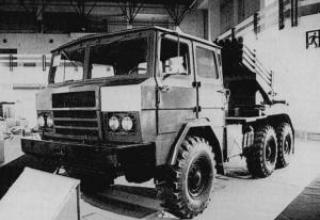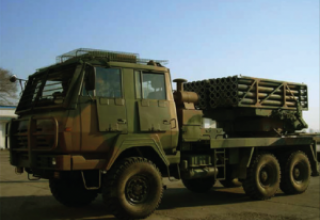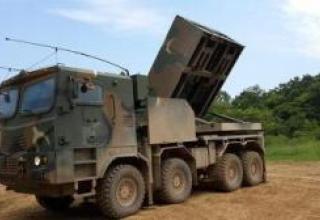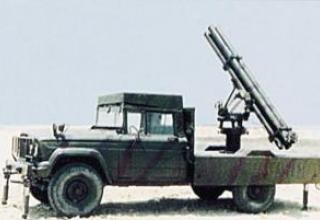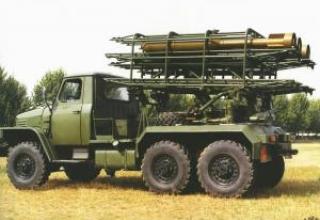The Hurricane Multiple Rocket Launcher System (MRLS) is designed to engage the living force, light armoured and armoured vehicles of the enemy's motorized infantry and tank units at the concentration sites and on the march, to destroy command posts, communication nodes and military industrial infrastructure facilities, to remotely install anti-tank and anti-personnel minefields in the combat zone at a distance of 10 to 35 km.
Taking into account the adoption of the M-21 Field Rocket System in 1963, the Tula State Research Institute of Precision Mechanical Engineering initiated a search work in 1963-1964 in order to study the possibility of creating a more powerful system in terms of the quantity of explosives in the salvo, a longer range system with the help of which it would be possible to solve in operational mode combat tasks at ranges from 10 to 35-40 km.
In June 1964, the Ministry of Mechanical Engineering was sent the "Hurricane Field MLRS Project with a projectile range of 35 km" for consideration. The project proposed a system with high maneuverability, travel speed of up to 70 km/h, high cross-country ability and the ability to open volley fire in a short time, which could be used to combat manpower, both openly located and hidden in field structures, firearms, tanks, nuclear and chemical weapons and other enemy targets and objects at ranges up to 35-40 km.
On the basis of the order of the Ministry of Defense Industry (MOD), dated 28.12.1966, in 1967 there was started the research "Creation of high-precision multiple launch rocket complex "Hurricane" (NV-121-66). The work was completed in December 1967 with the confirmation of the possibility of obtaining the specified characteristics, carrying out theoretical studies, bench tests of engines, the mechanism of delay of stabilizer opening, separation mechanism, aerodynamic blowing and firing of model projectiles, and recommended for experimental design work (RDW).
The results of the work performed were approved by IOM sub-section No. 1 of section 1 of NTS and the topic was recommended for RCD after elimination of the noted shortcomings.
There are also other data, according to which in 1967 the research theme was completed and the conceptual design of the complex was developed, confirmed by bench tests of projectile units and launcher, as well as tests of firing of model projectiles. As a result of the work performed, the conclusion was made about the possibility and expediency of creating a Hurricane complex with the following characteristics:
| Caliber | 152÷180 mm |
| Range of fire | 30÷35 km |
| Blast effect of the projectile | not worse than 180 mm OF shell |
| Shattering effect | specified shrapnel kill zone lying down at least 1300 m2 |
| Pile of fighting: | |
| in the direction of W/w | 1/180 |
| at range W/w | 1/200 |
| Number of guides | 25÷30 |
| Chassis type | crawler |
The "Hurricane" complex with the given characteristics exceeded the standard "Grad" system and considerably surpassed the known domestic samples, therefore it was recommended to carry out developmental work.
On the basis of the Order of the Minister of Machine Building and Minister of Defense Industry No.18/94 dated February 27, 1968, according to the basic requirements of part 64176 (out. No. a/774378 dated March 30, 1968), in the III quarter 1968 the advance design of "Uragan" complex was finished.
The "Hurricane" complex was designed for suppression and destruction of the enemy's manpower and equipment in the places of concentration at ranges up to 35 km.
The complex was developed as a part of it:
- of an unguided jet projectile;
- a combat vehicle;
- commander's vehicle;
- transport and charging machine.
As a result of the work performed, the following characteristics of the complex were obtained:
| Missile calibre | 200-210 mm |
| Weight of projectile | not more than 205 kg |
| Weight of combat unit | 45 kg |
| Range of fire | 12-35 km |
| Firing accuracy | ±1300-1400 m |
| Combat vehicle chassis | wheeled ZIL-135LM and tracked - "object 123" |
| Number of war machine rails: | |
| at ZIL-135LM | 24 pcs. |
| at facility 123 | 24-27 pcs. |
| TZM chassis | are the same as the ones for combat vehicles. |
For the "Hurricane" complex, it was shown that it was possible and expedient to create a shrapnel-flagged combat unit, a combat unit with special filling, as well as cluster combat units with shrapnel effect. These combat units were recommended for research and development.
For combat units for remote mine-mining with anti-personnel and anti-tank mines and firing units, research and development work with the production and testing of prototypes was necessary.
As a result of the vehicle project, it has been demonstrated that radio-technical firing can be used to improve firing accuracy. In case of application of radiotechnical shooting accuracy of "Hurricane" complex could be received not worse than ±1000 m.
The radiotechnical shooting machine could be created either as an independent commander's vehicle or as a modification of the combat vehicle. In the latter variant, the number of guides had to be reduced to accommodate the radiotechnical sighting equipment.
The question of the expediency of creating a radio technical bayonet in the "Hurricane" complex required further study.
The "Hurricane" complex vanproject was approved by the 2nd Main Department (out. № I-6226 of 27.II.68) and the decision of sub-section № 2 of section № I of NTS Minmash (out. I-6224 of 4.I2.68) and recommended for experimental development work.
There are also data, according to which, in order to eliminate these shortcomings discovered during the research, on the basis of the order of MM and MOE ¹ 18/94 in 1968 was developed by the Avanproject of multiple launch rocket system "Hurricane" and in September 1968, the work was recommended for the OCR (from the document TULGOSNITOCHMASH (Tula) of the early 70s).
In 1969 - the beginning of 1970 works on drawing up and adjustment of tactical and technical requirements for development work have been carried out: "The army multiple launch rocket system" "Grad-3" (on changes of the beginning of 1970 "Hurricane"). Probably, this is TTT ¹0010 of military unit 64176. It was to include a combat vehicle, a transport vehicle, a command vehicle, and arsenal equipment. The following types of head units were offered: high-explosive (with a specified crushing of the hull), cassette shrapnel, cassette for remote terrain mining. The decision to develop combat units of other types (cumulative, incendiary, agitation and special filling) was to be made by the Ministry of Defense and the Ministry of Mechanical Engineering according to the results of the advance project in the second quarter of 1970 . The projectiles design was to use one solid propellant jet engine with unregulated nozzle(s) throughout the entire operating temperature range for all types of combat units. Replaceable nozzles were not permitted. The ZIL-135LM chassis was offered as a base. At the stage of conceptual design the variants of combat and transport vehicles on the chassis of the MT-C tracked transporter-tractor (see variant TTT for the RSZO "Grad-3" ("Hurricane") and TK for the revision of the command vehicle for the system "Grad-3" ("Hurricane") should have been worked out. The number of guides was set to 20 when using ZIL-135LM chassis and 24 when using MT-C chassis. However, the exact number of guides was to be specified according to the results of the sketch design review. A variant on the wheel chassis of the Kraz-253 truck was also considered as the base of the transport vehicle.
From the letter of A.N. Ganichev (TULGOSNITOCHMASH) to Yelagin (GRAU) at w.h. 64176, it became known that the Ministry of Foreign Affairs and the Ministry of Defense approved the following implementing organizations for the system "Grad-3":
MINMASH:
- Research Chemical and Technological Institute (Lyubertsy, Moscow region, A-7210) on development of powder charge with ignition system;
- Plant "Krasnoarmeets" with the State Design Bureau ... instrumentation (Leningrad, V-8475) on ignition means;
- Kazan Research Institute of Chemical Industry (Kazan, V-2281) on the bouncing charge for cassette head units;
- Maslennikov Plant (Kuibyshev, R-6833) on contact-acting fuse for high-explosive warheads and mechanical remote tube for cassette warheads;
- Institute "Geodesy" (Krasnoarmeysk, Moscow region, suburb R-6766) for testing and evaluation of combat unit efficiency;
- Research Institute "Search" (Leningrad, V-8921) on contact fuse for a cassette warfare unit;
- The Red Army Research Institute of Mechanization (Krasnoarmeisk, Moscow region, substation A-7690) for equipment of a high-explosive warhead and explosive charge for a cluster warhead);
- Orsk mechanical plant (Orsk, Orenburg region, substation R-6286) for the manufacture of engine casings and combat units.
MINOBOROMPROM:
- Perm Machine-Building Plant named after V.I. Lenin (Perm, settlement R-6760) in combat and transport vehicles;
- All-Union Scientific Research Institute "Signal" (Kovrov, Vladimir region, unit A-1658) to refine the commander's machine.
Works on creation of the "Hurricane" system were carried out on the basis of the USSR Council of Ministers Decree No. 71-26 of January 21, 1970 (Order No. 33 of the Minister of Mechanical Engineering of January 28, 1970).
For January-February 1971, in order to check the activities related to the work on increasing the range of firing, it was planned to fire 30 pieces of "Hurricane" system shells from the ballistic unit on the ML-20 carriage. Three types of plumage were to be delivered:
- a knife type, with a 7 mm thick nib, and the opening of the feathers at an angle of 90° to the longitudinal axis of the projectile (probably meant up to an angle of 90°);
- according to the "Grad" projectile pattern;
- Combined (combining the plumage of a Grad projectile with a knife type).
The blowing of projectile variants with three types of plumage at TsAGI yielded positive results. Resistance margin was ~12%.
The letter of April 26, 1972, mentions the work on fiberglass pipes for 9P140 and 9P139 war machine guide packages.
In 1972, TulgosNIItochmash carried out work on the topic HB2-154-72 "Single-channel system of angular stabilization to the projectiles such as "Grad" and "Hurricane" (the beginning of work - 1 quarter 1972, the end - 2 quarter 1973).
In 1972, the study of the design of a single-channel system of angular stabilization was conducted in two directions:
- based on an angular velocity sensor using gas-dynamic actuators;
- based on a contact angle sensor with powder pulse actuators.
According to the report of TulgosNIItochmash about work in 1972, theoretical calculations, modeling on analogue electronic machines, experimental laboratory researches of single-channel system of angular stabilization and its elements for uncontrolled rockets such as "Grad" and "Hurricane: The main requirements to the system and its elements were defined.
The single-channel angular stabilization system consisted of an angular displacement sensor, an electronic conversion unit, and executive bodies of a gas-dynamic (or pulse) type.
It was determined that application of the single-channel angular stabilization system in the Grad and Hurricane projectiles improves their performance by 1.5-2 times.
Drawings were developed for the elements of the angular stabilization system, prototypes were produced and tested in laboratory conditions. At the time of drawing up or submission of the report, a batch of blocks of single-channel angular stabilization system was being produced for flight tests.
In 1972, on the basis of the order of the Head 2 of the Main Directorate of the Ministry of Mechanical Engineering dated December 20, 1970, No.17, TulgosNIItochmash carried out research work on the topic "Investigation of ways to create long-range projectiles for systems such as "Grad" and "Hurricane" (topic HB2-110-71g).
In accordance with the target task of the theme, theoretical and experimental works were carried out, which demonstrated the possibility of increasing the range of the projectile systems "Grad" and "Hurricane" through the use of strong materials for the hull and high-pulse fuels.
In 1972, it was recommended that research and development work should be carried out to develop the Hurricane system (obviously meaning the development of a projectile or shells) with an extended range of up to 40 km.
In 1972, the factory development was completed and the system was presented for testing at the range in the following composition:
- Unmanned rockets with high-explosive (100-105 kg) and cluster-shrapnel (80-85 kg) warheads;
- 9P140 fighting vehicle on ZIL-135LM chassis;
- 9T452 transport and charging vehicle on ZIL-135LM chassis;
- arsenal equipment.
At the stage of factory development the characteristics of the system meeting the main tactical and technical requirements were obtained:
- The maximum range of projectiles with a high-explosive warhead is 34 km, with a cassette warhead is 35 km..;
- heap of firing:
- The projectile with the high-explosive warhead: in the range I/X = 1/197, in the direction I/X = 1/174.
- The projectile with the cassette warhead: in the range I/X = 1/261, in the direction I/X = 1/152.
- The area of engagement of a cluster munition with a cluster munition provided that the warheads approach target 85-90°:
- Open-mounted manpower (Jud. = 10kg/cm2) - 22090m2
- of military equipment (Jud. = 135kg/cm2) - 19270m2
- The given area of destruction by blast combat unit: military equipment (Eud = 240 kg/cm2) - 1804m2;
- Funnel size: diameter 8m, depth 4.8m.
The number of guides of the combat vehicle - 18; salvo time - 9 sec, carryable ammunition on the transport and charging machine - 1 set.
Chief Designer of the fighting vehicle Yuri Kalachnikov.
According to the data dated 1986, the Uragan MRZO (in the source - BM-27 combat vehicles) were in service not only in the Soviet Army, but also in the army of Syria, and according to some reports in the army of Libya.
Currently, the system is in service with the armies of Russia, Kazakhstan, Belarus, Ukraine, Yemen and Syria.
Hurricane MLRS was widely used in combat operations in Afghanistan, during which it was used to defeat ground targets, especially for surprise attacks from various natural shelters, as well as for fire support during tactical helicopter raids and operations to destroy ground targets. In the early 1980s, it was deployed and used by the Syrian military in the initial phase of the war with Israel. The system was used in Transcaucasia (as of 1991), by Russian federal troops in the Chechen Republic and during the Georgian-South Ossetian conflict of 2008 by Russian troops. Between 2014 and 2015, the system was used by the Armed Forces of Ukraine (AFU) against militias in south-eastern Ukraine.
In Ukraine, work was carried out to install an artillery unit on the chassis of the KrAZ-6322 truck, which had been modified for its installation. The time of work performance has not been set.
Composition:
The Hurricane MLRS consists of the following combat vehicles:
- Combat vehicle BM 9P140 (see diagram)
- Transport charger 9T452 (see diagram)
- Rocket projectiles
- Complex of automated fire control (CALC) 1B126 "Kapustnik-B".
- Educational and training facilities
- Car for topographic survey 1T12-2M
- Radiation direction finding meteorological complex 1B44
- Set of special arsenal equipment and tools 9F381
Fighting vehicle 9P140 is made on the chassis of a four-axle vehicle with high cross-country ability ZIL-135LMP (wheel configuration 8x8). The artillery part includes a package of sixteen tubular rails, swivel base with guidance mechanisms and sighting devices, counterbalancing mechanism, as well as electrical and hydraulic equipment. Guidance mechanisms equipped with power drives make it possible to guide the guide package in the vertical plane from 5° to the maximum elevation angle of +55°. The angle of horizontal guidance is ±30° from the longitudinal axis of the machine. To increase the stability of the launcher when shooting at the rear of the chassis there are two supports equipped with manual drive jacks. The reactive projectiles can be transported directly into the rails. The PM is equipped with communication facilities (radio station R-123M) and a night vision device.
Tube guides are smooth wall tubes with a screwed U-slot through which a jet pin slides when fired. This ensures that the projectile is initially unwound to give it the necessary stability in flight. As the projectile travels along the trajectory, its rotation is supported by the projectile's opening stabilizer blades, set at a certain angle to the projectile's longitudinal axis. The salvo of one LM covers an area of more than 42 hectares. The main method of firing is from a closed position. Firing from the cabin is possible. BM 9P140 - 6 persons (4 persons in peacetime): BM commander, gunner (senior gunner), driver mechanic, number of calculation (3 persons).
The package of guides is mounted on a cradle - a welded rectangular platform (see layout diagram). With the upper machine the cradle is connected by two poles, around which it rotates (swings) when hovering at an elevation angle. The whole set of guides, the cradle, a number of parts and components of the locking mechanism, the ignition system, the sight bracket, etc. is a swinging part. The rotating part of the LM serves for giving the package of guides the necessary azimuth angle and includes the oscillating part, the upper machine tool, balancing, lifting and rotating mechanisms, epaulettes, the gunner's platform, manual drive of guidance, the mechanism of locking the oscillating part, hydrolocking of the oscillating part, the mechanism of locking the rotating part. The balancing mechanism serves for partial compensation of the moment of weight of a swinging part and consists of two torsoes and fastening details. Lifting and swiveling mechanisms serve for guidance of a package of guides on an elevation angle and in a horizontal plane. The main method of guidance is electric drive. In case of failure and during repair the manual drive is used. The locking mechanisms fix the moving parts of the set point while moving. The hydraulic lock of the oscillating part prevents shoot down of the alignment on an elevation angle and unloads the lifting mechanism at shooting.
The combat vehicle is fitted with the D726-45 mechanical panoramic sight. The sight uses the PG-1M standard panorama gun as a sight for sighting and angle measurement.
The BM 9P140 launcher system provides:
- safe operation of the calculation that serves the PM when firing,
- single- and multiple-launch fire when you're in the cockpit,
- Soldier and multiple rocket launchers at a distance of up to 60m from the LM in the shelter,
- firing when the main firing circuits and power supplies fail.
The launch system provides the possibility of multiple firing at a constant rate (all 16 missiles are launched at a rate of 0.5 s), as well as the so-called "torn" rate of firing (the first 8 missiles with a rate of 0.5 s, the remaining 8 missiles with a rate of 2 s). Due to the application of "torn" firing rate it is possible to significantly reduce the amplitude and frequency of the PM oscillations, and, consequently, to improve the pile-up of the firing.
Charging of the launcher is carried out using the 9T452 transport and charging machine, designed on the same wheeled chassis as the combat vehicle. Each TZM 9T452 transports 16 rockets and provides charging and discharging without special preparation of position including from any transport vehicle, from another TZM and from the ground. The recharging process is mechanized, its duration is 15 minutes. Carrying capacity of the TZM crane is 300 kg.
The TZM equipment consists of a frame, a tray with a dispatcher, a crane, cargo trolleys, an operator's platform, a load-carrying device, a device for docking, a crane turning gear, a boom, a verification mechanism, electrical equipment, and a ZIP. Messenger tray is a folding beam on which a pusher with a rocket moves. Reconciliation mechanism is designed to align the axis of the missile, which is located in the tray, with the axis of the guide tube. The trolleys on the left and right are designed to accommodate the missiles. There are three electric drives on the TZM: lifting (lowering) of rockets, crane turning, sending rockets to the guides.
Charging of the BM is carried out from the upper tier in the following sequence: lift the rocket and put it in the tray, unhook the load-carrying device and make the delivery of the rocket in the guide (see the scheme of mutual location of BM 9P140 and TZM 9T452 when charging and the scheme of location of the battery BM on the firing line).
Feature of the four-axle wheeled chassis ZIL-135LMP vehicle - the location of the power plant behind the four-seater crew cabin. This power unit consists of two V-shaped eight-cylinder carburetor ZIL-375 engines. Each of these engines at 3200 rpm develops a maximum power of 180 hp. Transmission is made according to the onboard scheme: the wheels of each side are driven in rotation from an independent engine through a separate gearbox, transfer gearboxes and final drives. Wheels of the first and fourth axles are controlled, have independent torsion suspension with shock absorbers. The wheels of the middle axles are close together, the elastic suspension is not and is rigidly fixed to the frame. The machine is equipped with a centralized air pressure control system in tires. The machine has very high cross-country ability and good speed characteristics. When driving on the highway with full load, it reaches a speed of 65 km / h, without prior preparation overcomes fords 1.2 m deep. The range of travel on fuel is 500 km.
Ammunition of "Hurricane" MLRS includes the following rockets:
- 9M27F with shrapnel header
- 9M27K with a cassette head unit equipped with shrapnel warheads
- 9M27S with an incendiary header
- 9M59 with cassette head unit equipped with anti-tank mines
- 9M27K2 with cassette head unit equipped with anti-tank mines
- 9M27K3 with cassette head unit equipped with antipersonnel mines
- 9M51 with detachable head part of volume detonating action.
The maximum firing range is 35 km, and for shorter ranges, rings are put on the projectile to brake it in flight. With a small ring, the flight range of cassette shells is from 11 to 22 km, NURS 9M27F - from 8 to 21 km. When using a large brake ring, the flight range of cassette shells is from 9 to 15 km, 9M27F - from 8 to 16 km.
Operation of the complex is possible in conditions of enemy's use of nuclear, chemical, bacteriological weapons at any time of year and day, in various climatic conditions at ambient air temperature from -40°C to +50°C.
Hurricane" LLRS can be transported by railway, water and air transport.
For the organization of serial production of housing parts of the Hurricane and Smerch RSZOs at the enterprises of the branch the specialized mills of PPT-200, PPT-200S, PPT-350 and others models were purchased, which according to the data for 2005 were successfully used at a number of enterprises for the production of housing parts.
Characteristics:
| Fighting vehicle 9P140 | |
| Weight of the BM in combat position, t | 20 |
| BM weight without shells and calculation, t | 15.1 |
| Dimensions in camping position, m | 9.630*2.8*3.225 |
| Wheel formula | 8x8 |
| Number of guides, pcs. | 16 |
| Guide rotation, deg | 240 |
| Recharging time, min | 15 |
| Traffic reserve on the highway, km | 500 |
| The time to transfer the ballistic missile from a camping position to a combat position is no more than, minutes. | 3 |
| Time of urgent leaving the firing position after the salvo is not more than, min. | 1,5 |
| Temperature range of combat application, ° C | -40..+50 |
| Surface wind, m/s | up to 20 |
| Relative air humidity at 20...25°C, % | up to 98 |
| Ground air dust, g/m3 | up to 2 |
| Altitude above sea level, m | up to 3000 |
| Jet shells. General characteristics | |
| Caliber, mm | 220 |
| Mass of solid propellant powder charge, kg | 104,1 |
| Range of fire maximum, km | 35 |
| Range of fire is minimal, km | 8 |
| Temperature range of combat application, ° C | -50..+50 |
| Temperature range of short term (up to 6 hours) stay of RS, °С | -60..+60 |
Testing:
According to data dated July 2018, the Soviet side sold the rockets and other components of the Hurricane system (it is worth understanding the Hurricane MLRS) to the Syrian side. Some of these rockets were handed over to the Hezbollah movement in the early 2000s.
In 2002, Alyazhedinov Vadim Rashitovich, Skirda Viktor Andreevich was awarded the S.I. Mosin Prize for his work on the topic: "The Hurricane multiple launch rocket system with increased accuracy and heap of fire.
Sergei Sivtsov - designer of control system elements. He made a significant contribution to the development of correcting switchgears for the angular stabilization systems of Smerch and Uragan Rocket Launcher Systems. He took direct part in working out of the given elements, tests and their introduction in a batch production.
Sources:
- Автомобильное шасси 135ЛМ. Техническое описание и инструкция по эксплуатации, 1970. – С. 157.
- Барановский М.Н. Реактивная система залпового огня 9К57 “Ураган”. Основы устройства и подготовки к боевому применению. – Михайловская Артиллерийская Академия. – 1996. – С. 79.
- Белобрагин Б.А., Буров А.Н., Поляков В.И., Алексеев В.А., Шишов И.В. Утилизация опасных в обращении реактивных снарядов 9М27К3 // Актуальные проблемы утилизации ракет и боеприпасов. Сборник докладов. – М.: "Типография ФКП "НИИ "Геодезия", 2012. – С. 383.
- Белов Е.А. Ротационная вытяжка корпусных деталей реактивных снарядов // Оборонная техника. – Специальный выпуск. – Москва, 2005 – № 6-7. – С. 113.
- Боевая машина 9П140. Альбом рисунков к техническому описанию и инструкции по эксплуатации 9П140ТО1. – М.: Воениздат, 1983. – С. 3,4.
- Боевая машина 9П140/"ФГУП ГНПП "Сплав"/
- Видоизмененный макет боевой машины 9П140 РСЗО “Ураган” в открытой экспозиции продукции военного назначения Народного музея ОАО “Мотовилихинские заводы” (г. Пермь);
- Временные таблицы стрельбы 220-мм реактивными снарядами 9М27Ф и 9М27К. – М.: Министерство обороны СССР. – 1977. – С. 187,188.
- Выпуски новостей информационной программы "Вести" телеканала РТР от 12.08.2008 г. Выпуски в 20.00 и после 23.00 по мск.
- ГАУ ТО “ГА”. Ф. Р-3428. Оп. 1. Д. 799. Л. 8.
- ГАУ ТО “ГА”. Ф. Р-3428. Оп. 1. Д. 858. Л. 6-8.
- ГАУ ТО "ГА". Ф. Р-3428. Оп. 1. Д. 1000. Л. 1.
- ГАУ ТО "ГА". Ф. Р-3428. Оп. 1. Д. 1079. Л. 1-2.
- ГАУ ТО "ГА". Ф. Р-3428. Оп. 1. Д. 1104. Л. 14.
- ГАУ ТО "ГА". Ф. Р-3428. Оп. 1. Д. 1128. Л. 35-37.
- ГАУ ТО "ГА". Ф. Р-3428. Оп. 1. Д. 1160. Л. 131.
- ГАУ ТО "ГА". Ф. Р-3428. Оп. 1. Д. 1169. Л. 10,11,29,30,32.
- ГАУ ТО "ГА". Ф. Р-3428. Оп. 1. Д. 1187. Л. 43.
- Данные на табличке для макета боевой машины 9П140 РСЗО "Ураган" в экспозиции Народного музея истории завода АО "Мотовилихинские заводы" (г. Пермь, 06.07.2009 г.)
- Изделие 9Т452. Альбом рисунков к техническому описанию и инструкции по эксплуатации 9Т452 ТО1. – Изд.№6/156661р-П86 з/н. – С. 3.
- Кадочников В.Н. Молнии над полигоном. - Издатель ИП А.В. Горев. – 2008. – С. 129.
- О присвоении индексов реактивной системе залпового огня "Ураган"
- Отчет по выявлению причин аномального функционирования на траектории РС 9М27К системы "Ураган" в Республике Афганистан.
- Паспорт экспортного облика №2748/01/НЭК на 220-мм реактивный снаряд 9М27Ф с осколочно-фугасной головной частью к реактивной системе залпового огня “Ураган”. Перерегистрирован: 30.04.2004 г. Копия.
- Паспорт экспортного облика №2750/01/НЭК на 220-мм реактивный снаряд 9М27к с головной частью осколочного действия к реактивной системе залпового огня “Ураган”. Перерегистрирован: 30.04.2004 г. Копия.
- Паспорт экспортного облика №2738/01/НЭК на 220-мм реактивный снаряд 9М27К2 противотанкового минирования к реактивной системе залпового огня “Ураган”. Перерегистрирован: 30.04.2004 г. Копия.
- Паспорт экспортного облика №2746/01/НЭК на 220-мм реактивный снаряд 9М59 с противотанковыми минами к реактивной системе залпового огня “Ураган”. Перерегистрирован: 30.04.2004 г. Копия.
- Премия имени С.И. Мосина: из века в век. – М.: Издательский дом «Оружие и технологии», 2018. – С. 145,434,435,440.
- Применение в Афганистане боевых машин реактивной артиллерии БМ-27 // Иностранная печать об экономическом, научно-техническом и военном потенциале Советского Союза, стран-участниц Варшавского договора и технических средствах его выявления. Серия: «Вооруженные силы СССР». – Москва. – 1986. – № 10. – С. 46,47. Со ссылкой на Jane’s Defence Weekly, 1986, 5, № 19, p. 886.
- Реактивные снаряды системы залпового огня 9К57. Техническое описание и инструкция по эксплуатации. Часть 2. – М.: Воениздат. – 1988. – С. 4-5.
- Рекламный паспорт №2749/01/НЭК на 220-мм реактивный снаряд 9М27Ф с осколочно-фугасной головной частью к реактивной системе залпового огня “Ураган”. Перерегистрирован: 30.04.2004 г. Копия.
- Рекламный паспорт №2751/01/НЭК на 220-мм реактивный снаряд 9М27к с головной частью осколочного действия к реактивной системе залпового огня “Ураган”. Перерегистрирован: 30.04.2004 г. Копия.
- Рекламный паспорт №2739/01/НЭК на 220-мм реактивный кассеьный снаряд 9М27К2 противотанкового минирования к реактивной системе залпового огня “Ураган”. Перерегистрирован: 30.04.2004 г. Копия.
- Рекламный паспорт №2747/01/НЭК на 220-мм реактивный снаряд 9М59 с противотанковыми минами к реактивной системе залпового огня “Ураган”. Перерегистрирован: 30.04.2004 г. Копия.
- Решение № 15 Совета главных конструкторов по системе “Ураган” (г. Тула, 7-8 декабря 1972 г.
- Служебная командировка советских специалистов в Афганистан в 1990 году по вопросам РС РСЗО "Ураган"
- ЦАМО РФ. Ф.81. Оп. 856348сс. Д. 323. Л. 161,162,169,172,225,226.
- Червонопиский С.В., Костыря А.А., Сироштан В.Г. Военно-политическая спецоперация СССР в Афганистане (25 декабря 1979 - 15 февраля 1989 гг.) Словарь-справочник. – 2-е издание, переработанное и дополненное. - К.: Межрегиональный издательский центр “Мединформ”, 2007. – С. 251.
- http://legion.wplus.net/guide/army/rs/index.shtml
- http://paralay.iboards.ru
- http://www.militaryparitet.com/nomen/russia/rocket/nureaktsys/data/ic_nomenrussiarocketnureaktsys/9/
- http://spioenkop.blogspot.ru/2014/11/syrias-bm-27-uragans-emerging-from.html
- THE 82 MM ALAZAN ROCKET ‐‐ AN IMPROVISED POST‐SOVIET WEAPON // Jane's Intelligence Review. Posted 1992-Oct-01. Электронная база Jane's по подписке в Российской Национальной Библиотеке (РНБ, Россия, г.Санкт-Петербург). URL: https://janes.ihs.com/CustomPages/Janes/DisplayPage.aspx?DocType=News&ItemId=+++1675043&Pubabbrev=JIR
- Shaan Shaikh and Ian Williams. Hezbollah’s Missiles and Rockets. – P. 4. [Электронный ресурс]. Дата обновления: июль 2018 г. // URL: https://csis-prod.s3.amazonaws.com/s3fs-public/publication/180705_Williams_HezbollahMissiles_v2.pdf (дата обращения: 18.12.2019 г.)
